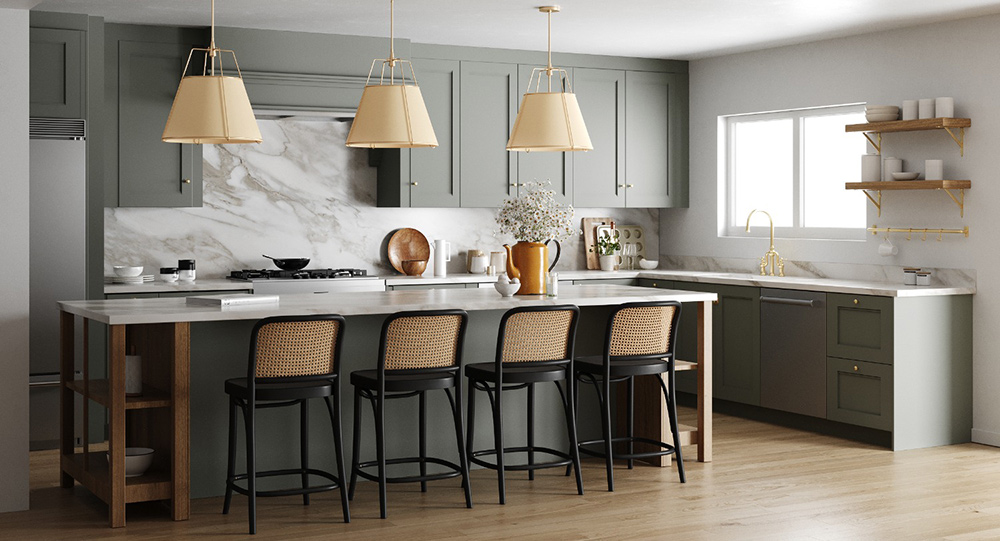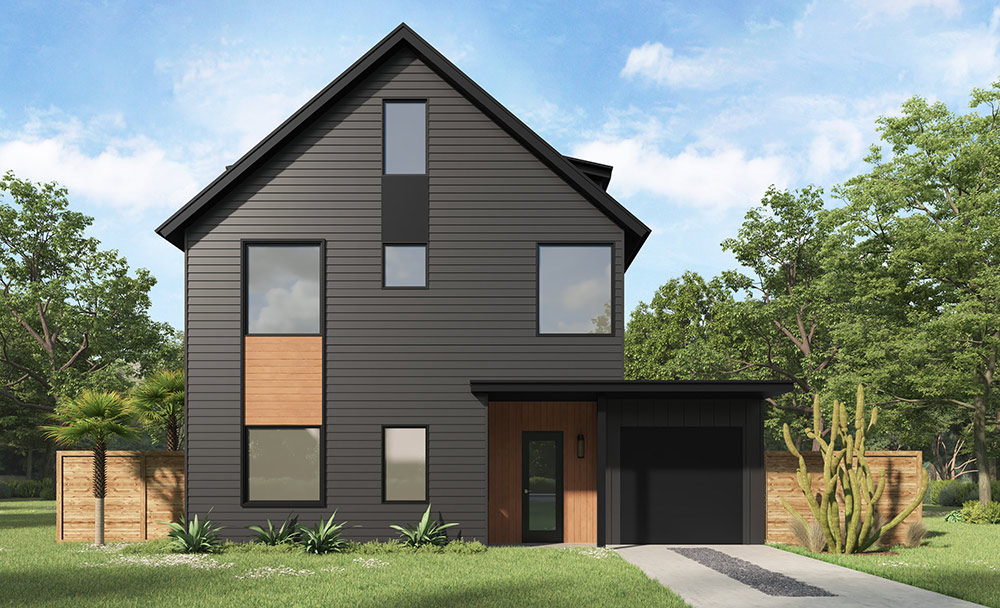美國HGTV頻道的節(jié)目讓房屋裝修看起來輕而易舉。但實(shí)際上,從重新設(shè)計(jì)廚房、裝修新洗手間或者從零開始新建一棟房子,都是一個(gè)復(fù)雜且漫長的過程,通常要有多方專業(yè)人員花費(fèi)幾個(gè)月進(jìn)行協(xié)調(diào),需要投入數(shù)萬美元,還要遵守大量復(fù)雜的建筑法規(guī)和許可。
隨著人工智能的出現(xiàn),房屋的裝修過程變得更快、更簡單、成本更低,甚至更可持續(xù)。
端對端裝修服務(wù)提供商Skipp的聯(lián)合創(chuàng)始人及首席執(zhí)行官伊恩·賈弗里說:“房屋裝修會(huì)給人們留下許多可怕的回憶,如果找不到恰當(dāng)?shù)膶I(yè)服務(wù),人們就會(huì)遇到各種問題。我們利用科技,向客戶提供非常精確的裝修方案。這讓整個(gè)裝修過程變得更簡單,使人們可以專注于靈感、透明度和預(yù)算。”
Skipp采用人工智能技術(shù)編制、分析和推薦房屋裝修方案。該公司目前的業(yè)務(wù)重點(diǎn)是廚房裝修,而這也是房屋裝修中最具有挑戰(zhàn)性的一個(gè)房間。首先,該公司使用3D攝像機(jī)精準(zhǔn)測量房屋尺寸,并將這些信息添加到系統(tǒng)。系統(tǒng)內(nèi)置的人工智能會(huì)跟蹤必要信息,例如天然氣管線布置、衛(wèi)生管道布置、窗戶以及建筑法規(guī)與標(biāo)準(zhǔn)等。然后,系統(tǒng)會(huì)根據(jù)業(yè)主的要求,比如優(yōu)化儲(chǔ)物或娛樂空間等,開始利用算法進(jìn)行計(jì)算。

通過使用人工智能技術(shù),Skipp能夠很快根據(jù)空間的限制條件量身定制多種不同方案,向業(yè)主展示符合其要求的可行的房間布局和模型。之后,該公司會(huì)為業(yè)主聯(lián)系相關(guān)領(lǐng)域的承包商,承包商收到需求建議書和設(shè)計(jì)要素后將開始施工。賈弗里表示,業(yè)主可以專注于“靈感方面”,例如櫥柜、門把手和廚房臺面材料等,不必再糾結(jié)于建筑圖紙和承包商的行話這些問題。
對于一間10×10英尺的廚房,Skipp通常會(huì)提出700種不同空間布置方案。賈弗里指出,有的廚房只需要一周的時(shí)間就能夠完成施工。
如果沒有人工智能,一間完整廚房的施工過程就需要耗費(fèi)更多的人力。賈弗里稱,設(shè)計(jì)師測量房間尺寸、繪制示意圖草案以及準(zhǔn)備不同布局方案,可能需要多達(dá)70個(gè)小時(shí)。之后還要向承包商協(xié)商報(bào)價(jià)和時(shí)間安排。賈弗里解釋道,廚房裝修平均耗時(shí)長達(dá)9至12個(gè)月。而通過使用Skipp提供的服務(wù),業(yè)主只需要45天就可以擁有一間新廚房。他補(bǔ)充說:“沒有人想花一年時(shí)間設(shè)計(jì)一間廚房。”
Skipp通過簡化裝修過程,還降低了整體成本。賈弗里表示,在Skipp總部所在的紐約市,廚房的平均裝修成本為12萬美元。而通過Skipp,裝修成本能夠降低到約35000美元,因?yàn)樗?jié)省了建筑師、設(shè)計(jì)師和承包商的時(shí)間。
與其他類型的人工智能一樣,隨著用戶增多,Skipp系統(tǒng)將變得更智能。隨著越來越多的業(yè)主選擇最符合預(yù)算和儲(chǔ)物要求的方案,該系統(tǒng)將學(xué)會(huì)用戶常選的組合,并推薦給未來的業(yè)主。隨著不斷學(xué)習(xí),系統(tǒng)還將提高推薦速度。賈弗里和他的團(tuán)隊(duì)希望將Skipp打造成一款實(shí)時(shí)家裝手機(jī)應(yīng)用程序,可以直接掃描房間,在幾分鐘后就能夠給出布局和設(shè)計(jì)方案。

不止Skipp一家公司在將人工智能應(yīng)用于住宅領(lǐng)域。Higharc和Homebound等主營建筑施工的公司也在努力簡化建模過程,為業(yè)主尋找建筑師、設(shè)計(jì)師和承包商等專業(yè)人員提供便利,最終使更多的人有機(jī)會(huì)擁有住房。這對于千禧一代尤其重要,目前50%的購房者是千禧一代。他們發(fā)現(xiàn)擁有住房的過程充滿了挑戰(zhàn)。賈弗里表示,美國80%的住房房齡超過20年,這意味著一個(gè)龐大的房屋裝修市場。
還有許多人計(jì)劃建房。邁克爾·伯金參與創(chuàng)建的Higharc公司可以幫助降低建房過程的復(fù)雜性。作為設(shè)計(jì)創(chuàng)新總監(jiān),他把公司的產(chǎn)品比喻成現(xiàn)代化的汽車配置器。客戶能夠直觀地看到數(shù)百種房屋選項(xiàng),包括實(shí)時(shí)定價(jià),保證了交易過程的透明度。與Skipp一樣,Higharc用人工智能系統(tǒng)取代了需要耗時(shí)數(shù)小時(shí)的人工操作,該系統(tǒng)可以輸出房屋布局、家電方案和其他設(shè)計(jì)要素等,并保證完全符合建筑法規(guī)。
伯金表示:“以前幾乎每一棟建筑都需要從零開始進(jìn)行設(shè)計(jì)。其他項(xiàng)目中的知識很難直接照搬。而Higharc使用知識庫捕捉和重復(fù)使用數(shù)據(jù),并持續(xù)改進(jìn)該系統(tǒng)創(chuàng)建的房屋的方案和質(zhì)量。”
除此之外,伯金指出,Higharc可靠的3D模型發(fā)現(xiàn)了一個(gè)令人意外的統(tǒng)計(jì)數(shù)據(jù):由于測量錯(cuò)誤,一棟房屋的建筑商浪費(fèi)了高達(dá)25%的木材,而Higharc通過人工智能技術(shù)能夠避免出現(xiàn)這種問題。這不僅可以節(jié)約成本,還能夠做到環(huán)保。
Homebound的業(yè)務(wù)類似,但其主要從事大規(guī)模住宅建設(shè)。2017年加州野火發(fā)生后不久,當(dāng)?shù)鼐用衿惹行枰路浚琀omebound的首席執(zhí)行官及聯(lián)合創(chuàng)始人尼基·佩赫特當(dāng)時(shí)成立了這家公司。該公司提供的服務(wù)類似于電商服務(wù),購房人可以在一個(gè)網(wǎng)站上選擇房屋的地塊、平面圖、建筑風(fēng)格和裝飾裝修等。在這個(gè)過程中,該技術(shù)平臺會(huì)評估一系列數(shù)據(jù),以簡化設(shè)計(jì)和建筑過程。佩赫特表示,與傳統(tǒng)大規(guī)模房屋建設(shè)項(xiàng)目相比,Homebound在設(shè)計(jì)階段的效率提高了8倍,施工速度提高了20%。
Homebound也為房屋開放商提供了協(xié)助。其數(shù)據(jù)庫中涵蓋了超過2500萬套住房,并且數(shù)量仍然在不斷增加。佩赫特的團(tuán)隊(duì)訓(xùn)練了可靠的算法,用于模擬地塊購買成本、預(yù)期建筑成本和房屋完工后的預(yù)期售價(jià),以預(yù)測大規(guī)模房地產(chǎn)開發(fā)的可行性。
佩赫特稱:“房屋建筑信息數(shù)量龐大,只有人工智能和機(jī)器學(xué)習(xí)能夠從不同項(xiàng)目、地區(qū)和市場中總結(jié)出規(guī)律。”她還表示,這對于規(guī)模達(dá)到約1.5萬億美元的房屋建筑行業(yè)具有巨大的影響。
道格·維克爾森是企業(yè)可視化平臺Renoworks的首席執(zhí)行官。該平臺服務(wù)承包商及其客戶。維克爾森將其比作亞馬遜(Amazon)。現(xiàn)在消費(fèi)者已經(jīng)習(xí)慣了用更短時(shí)間購買商品和服務(wù);因此人們自然也希望房屋裝修過程變得比傳統(tǒng)裝修過程更迅速,這并不意外。Renoworks已經(jīng)有20年的歷史。維克爾森發(fā)現(xiàn),對于人工智能和機(jī)器學(xué)習(xí)技術(shù)提供的功能和效率,人們的需求日益增加。
他表示,為了適應(yīng)這種趨勢,Renoworks的技術(shù)堆棧和基礎(chǔ)設(shè)施進(jìn)行了升級。與佩赫特、賈弗里和伯金一樣,維克爾森也認(rèn)為針對住宅建設(shè)面臨的諸多挑戰(zhàn),人工智能就是解決方案。
他說:“人工智能的目標(biāo)是省略額外的步驟,避免麻煩的決策,從而幫助消費(fèi)者專注于重要的事情,并幫助行業(yè)簡化對設(shè)計(jì)方案的解釋。人工智能正在幫助我們準(zhǔn)確預(yù)測客戶的偏好,從而避免決策過程中的所有麻煩。在房屋裝修領(lǐng)域,人工智能的應(yīng)用仍然處在初期階段,但未來有無數(shù)的可能性。”(財(cái)富中文網(wǎng))
譯者:劉進(jìn)龍
審校:汪皓
美國HGTV頻道的節(jié)目讓房屋裝修看起來輕而易舉。但實(shí)際上,從重新設(shè)計(jì)廚房、裝修新洗手間或者從零開始新建一棟房子,都是一個(gè)復(fù)雜且漫長的過程,通常要有多方專業(yè)人員花費(fèi)幾個(gè)月進(jìn)行協(xié)調(diào),需要投入數(shù)萬美元,還要遵守大量復(fù)雜的建筑法規(guī)和許可。
隨著人工智能的出現(xiàn),房屋的裝修過程變得更快、更簡單、成本更低,甚至更可持續(xù)。
端對端裝修服務(wù)提供商Skipp的聯(lián)合創(chuàng)始人及首席執(zhí)行官伊恩·賈弗里說:“房屋裝修會(huì)給人們留下許多可怕的回憶,如果找不到恰當(dāng)?shù)膶I(yè)服務(wù),人們就會(huì)遇到各種問題。我們利用科技,向客戶提供非常精確的裝修方案。這讓整個(gè)裝修過程變得更簡單,使人們可以專注于靈感、透明度和預(yù)算。”
Skipp采用人工智能技術(shù)編制、分析和推薦房屋裝修方案。該公司目前的業(yè)務(wù)重點(diǎn)是廚房裝修,而這也是房屋裝修中最具有挑戰(zhàn)性的一個(gè)房間。首先,該公司使用3D攝像機(jī)精準(zhǔn)測量房屋尺寸,并將這些信息添加到系統(tǒng)。系統(tǒng)內(nèi)置的人工智能會(huì)跟蹤必要信息,例如天然氣管線布置、衛(wèi)生管道布置、窗戶以及建筑法規(guī)與標(biāo)準(zhǔn)等。然后,系統(tǒng)會(huì)根據(jù)業(yè)主的要求,比如優(yōu)化儲(chǔ)物或娛樂空間等,開始利用算法進(jìn)行計(jì)算。
通過使用人工智能技術(shù),Skipp能夠很快根據(jù)空間的限制條件量身定制多種不同方案,向業(yè)主展示符合其要求的可行的房間布局和模型。之后,該公司會(huì)為業(yè)主聯(lián)系相關(guān)領(lǐng)域的承包商,承包商收到需求建議書和設(shè)計(jì)要素后將開始施工。賈弗里表示,業(yè)主可以專注于“靈感方面”,例如櫥柜、門把手和廚房臺面材料等,不必再糾結(jié)于建筑圖紙和承包商的行話這些問題。
對于一間10×10英尺的廚房,Skipp通常會(huì)提出700種不同空間布置方案。賈弗里指出,有的廚房只需要一周的時(shí)間就能夠完成施工。
如果沒有人工智能,一間完整廚房的施工過程就需要耗費(fèi)更多的人力。賈弗里稱,設(shè)計(jì)師測量房間尺寸、繪制示意圖草案以及準(zhǔn)備不同布局方案,可能需要多達(dá)70個(gè)小時(shí)。之后還要向承包商協(xié)商報(bào)價(jià)和時(shí)間安排。賈弗里解釋道,廚房裝修平均耗時(shí)長達(dá)9至12個(gè)月。而通過使用Skipp提供的服務(wù),業(yè)主只需要45天就可以擁有一間新廚房。他補(bǔ)充說:“沒有人想花一年時(shí)間設(shè)計(jì)一間廚房。”
Skipp通過簡化裝修過程,還降低了整體成本。賈弗里表示,在Skipp總部所在的紐約市,廚房的平均裝修成本為12萬美元。而通過Skipp,裝修成本能夠降低到約35000美元,因?yàn)樗?jié)省了建筑師、設(shè)計(jì)師和承包商的時(shí)間。
與其他類型的人工智能一樣,隨著用戶增多,Skipp系統(tǒng)將變得更智能。隨著越來越多的業(yè)主選擇最符合預(yù)算和儲(chǔ)物要求的方案,該系統(tǒng)將學(xué)會(huì)用戶常選的組合,并推薦給未來的業(yè)主。隨著不斷學(xué)習(xí),系統(tǒng)還將提高推薦速度。賈弗里和他的團(tuán)隊(duì)希望將Skipp打造成一款實(shí)時(shí)家裝手機(jī)應(yīng)用程序,可以直接掃描房間,在幾分鐘后就能夠給出布局和設(shè)計(jì)方案。
不止Skipp一家公司在將人工智能應(yīng)用于住宅領(lǐng)域。Higharc和Homebound等主營建筑施工的公司也在努力簡化建模過程,為業(yè)主尋找建筑師、設(shè)計(jì)師和承包商等專業(yè)人員提供便利,最終使更多的人有機(jī)會(huì)擁有住房。這對于千禧一代尤其重要,目前50%的購房者是千禧一代。他們發(fā)現(xiàn)擁有住房的過程充滿了挑戰(zhàn)。賈弗里表示,美國80%的住房房齡超過20年,這意味著一個(gè)龐大的房屋裝修市場。
還有許多人計(jì)劃建房。邁克爾·伯金參與創(chuàng)建的Higharc公司可以幫助降低建房過程的復(fù)雜性。作為設(shè)計(jì)創(chuàng)新總監(jiān),他把公司的產(chǎn)品比喻成現(xiàn)代化的汽車配置器。客戶能夠直觀地看到數(shù)百種房屋選項(xiàng),包括實(shí)時(shí)定價(jià),保證了交易過程的透明度。與Skipp一樣,Higharc用人工智能系統(tǒng)取代了需要耗時(shí)數(shù)小時(shí)的人工操作,該系統(tǒng)可以輸出房屋布局、家電方案和其他設(shè)計(jì)要素等,并保證完全符合建筑法規(guī)。
伯金表示:“以前幾乎每一棟建筑都需要從零開始進(jìn)行設(shè)計(jì)。其他項(xiàng)目中的知識很難直接照搬。而Higharc使用知識庫捕捉和重復(fù)使用數(shù)據(jù),并持續(xù)改進(jìn)該系統(tǒng)創(chuàng)建的房屋的方案和質(zhì)量。”
除此之外,伯金指出,Higharc可靠的3D模型發(fā)現(xiàn)了一個(gè)令人意外的統(tǒng)計(jì)數(shù)據(jù):由于測量錯(cuò)誤,一棟房屋的建筑商浪費(fèi)了高達(dá)25%的木材,而Higharc通過人工智能技術(shù)能夠避免出現(xiàn)這種問題。這不僅可以節(jié)約成本,還能夠做到環(huán)保。
Homebound的業(yè)務(wù)類似,但其主要從事大規(guī)模住宅建設(shè)。2017年加州野火發(fā)生后不久,當(dāng)?shù)鼐用衿惹行枰路浚琀omebound的首席執(zhí)行官及聯(lián)合創(chuàng)始人尼基·佩赫特當(dāng)時(shí)成立了這家公司。該公司提供的服務(wù)類似于電商服務(wù),購房人可以在一個(gè)網(wǎng)站上選擇房屋的地塊、平面圖、建筑風(fēng)格和裝飾裝修等。在這個(gè)過程中,該技術(shù)平臺會(huì)評估一系列數(shù)據(jù),以簡化設(shè)計(jì)和建筑過程。佩赫特表示,與傳統(tǒng)大規(guī)模房屋建設(shè)項(xiàng)目相比,Homebound在設(shè)計(jì)階段的效率提高了8倍,施工速度提高了20%。
Homebound也為房屋開放商提供了協(xié)助。其數(shù)據(jù)庫中涵蓋了超過2500萬套住房,并且數(shù)量仍然在不斷增加。佩赫特的團(tuán)隊(duì)訓(xùn)練了可靠的算法,用于模擬地塊購買成本、預(yù)期建筑成本和房屋完工后的預(yù)期售價(jià),以預(yù)測大規(guī)模房地產(chǎn)開發(fā)的可行性。
佩赫特稱:“房屋建筑信息數(shù)量龐大,只有人工智能和機(jī)器學(xué)習(xí)能夠從不同項(xiàng)目、地區(qū)和市場中總結(jié)出規(guī)律。”她還表示,這對于規(guī)模達(dá)到約1.5萬億美元的房屋建筑行業(yè)具有巨大的影響。
道格·維克爾森是企業(yè)可視化平臺Renoworks的首席執(zhí)行官。該平臺服務(wù)承包商及其客戶。維克爾森將其比作亞馬遜(Amazon)。現(xiàn)在消費(fèi)者已經(jīng)習(xí)慣了用更短時(shí)間購買商品和服務(wù);因此人們自然也希望房屋裝修過程變得比傳統(tǒng)裝修過程更迅速,這并不意外。Renoworks已經(jīng)有20年的歷史。維克爾森發(fā)現(xiàn),對于人工智能和機(jī)器學(xué)習(xí)技術(shù)提供的功能和效率,人們的需求日益增加。
他表示,為了適應(yīng)這種趨勢,Renoworks的技術(shù)堆棧和基礎(chǔ)設(shè)施進(jìn)行了升級。與佩赫特、賈弗里和伯金一樣,維克爾森也認(rèn)為針對住宅建設(shè)面臨的諸多挑戰(zhàn),人工智能就是解決方案。
他說:“人工智能的目標(biāo)是省略額外的步驟,避免麻煩的決策,從而幫助消費(fèi)者專注于重要的事情,并幫助行業(yè)簡化對設(shè)計(jì)方案的解釋。人工智能正在幫助我們準(zhǔn)確預(yù)測客戶的偏好,從而避免決策過程中的所有麻煩。在房屋裝修領(lǐng)域,人工智能的應(yīng)用仍然處在初期階段,但未來有無數(shù)的可能性。”(財(cái)富中文網(wǎng))
譯者:劉進(jìn)龍
審校:汪皓
HGTV shows make home renovations look straightforward. But in reality, the process of redesigning a kitchen, installing a new bathroom, or building a home from the ground up is a complex and lengthy process—one that often takes months of coordination among several professionals, tens of thousands of dollars, and plenty of perplexing building codes and permits.
With artificial intelligence, that process is becoming faster, easier, cheaper, and possibly more sustainable.
“A lot of horror stories come up with renovations, and people encounter those problems when they don’t have the right professional service at their side,” says Ian Jaffrey, cofounder and chief executive officer of Skipp, an end-to-end renovation service. “We’re leveraging technology that is really about getting precise plans in place for customers. Doing that makes that whole process easier and allows people to focus on inspiration, transparency, and budget.”
Skipp relies on A.I. to compile, analyze, and recommend home renovation options. Today the company is focused on kitchens, which happen to be the most challenging room in the home for a remodel. It starts with a 3D camera to capture precise measurements in the room and add those points of intelligence to the system. The embedded intelligence tracks necessary information—like the placement of gas lines, plumbing, and windows—plus architectural codes and standards. Then it takes into account the homeowner’s requests, such as optimizing the space for storage or entertaining, to start to apply an algorithm.
By using A.I., Skipp quickly tailors a number of different options within the constraints of the specific space to present the homeowner with layouts and mockups that will be feasible in the room and fit their personal requirements. The service then connects homeowners with contractors in their area, who receive specific requests for proposals and design elements to start the work. Homeowners can focus on the “inspirational aspects,” says Jaffrey, such as cabinetry, door handles, and countertop materials, rather than get bogged down by building paperwork and contractor jargon.
For a 10-foot-by-10-foot kitchen, Skipp typically comes up with 700 different permutations. Jaffrey says that they have had kitchens ready to be built in as little as a week.
Without the use of A.I. technology, the journey to a completed kitchen is much more manual. Jaffrey says that it can take a designer up to 70 hours just to measure and draft schematic plans, plus entertain various configurations. And that’s before you reach out to contractors for quotes and timelines. Jaffrey explains that the average kitchen renovation takes nine to 12 months. With Skipp, homeowners can have a new kitchen in just 45 days. “No one wants to spend a year of their life planning a kitchen,” he adds.
By streamlining the process, Skipp also makes the entire renovation more accessible financially. In New York City, where Skipp is based, Jaffrey says that the average kitchen renovation is $120,000. Skipp can do it all for about $35,000, simply by reducing the amount of time it takes architects, designers, and contractors.
Like any type of A.I., the Skipp system gets smarter as more users log on. As an increasing number of homeowners select options that optimize for budget and storage, the system will learn what combinations are typically chosen, working to offer those up to future homeowners. It also learns to make recommendations more quickly. Jaffrey and his team aim for Skipp to be home renovations in real time: an instantaneous phone application that scans the room, then offers configurations and design options in mere minutes.
Skipp is not alone in its development of A.I. for homes. It joins construction-focused companies like Higharc and Homebound in its drive to simplify the modeling process, access to professionals like architects, designers, and contractors, and ultimately make housing more accessible. It’s particularly significant for the millennial population, who account for 50% of current home purchases. They have largely found the homeowning experience to be rife with challenges. According to Jaffrey, 80% of the homes in the U.S. are more than 20 years old, which opens a large market for home renovations.
Then there are those looking to build a home. Michael Bergin cofounded Higharc to help reduce the complexity of the homebuilding process. As the director of design innovation, he likens his product to a modern car configurator. Buyers can visualize hundreds of home options with real-time pricing for instant transparency. Like Skipp, Higharc replaces hours of manual drafting with an A.I. system to export layouts, appliance options, and other design elements, all while maintaining compliance with the nuances of building codes.
“Buildings in the past were designed from scratch in nearly every case,” Bergin says. “Carrying knowledge through projects was impossible. Higharc uses a knowledge base to capture and reuse data and continuously improve the options and quality of the homes created in the system.”
In an added benefit, Bergin says that Higharc’s reliable 3D model revealed a surprising statistic: Builders wasted up to 25% of the lumber ordered for a home due to errors in measurement, a hurdle that Higharc avoids thanks to A.I. That’s not only a cost savings, but an environmental one too.
Homebound is doing something similar, but for homes at scale. CEO and cofounder Nikki Pechet launched Homebound in the wake of the 2017 wildfires in California, when residents in the area needed new homes quickly. The service works like an e-commerce experience in which buyers can select a lot, floor plan, architectural style, and finishes all through one online portal. In the process, the technology platform amassed a serious amount of data to streamline the design and building process. Pechet says that Homebound is eight times more efficient in the design phase, and construction moves 20% faster than traditional large-scale home construction projects.
It has also aided home developers. Homebound has a growing database of more than 25 million properties. Pechet’s team has trained robust algorithms to model out the site acquisition cost, expected built costs, and expected sell prices of finished homes to forecast the feasibility of large-scale property development.
“The volume of homebuilding information is so large that only A.I. and machine learning can see patterns across projects, jurisdictions, and marketplaces,” Pechet says. That’s hugely impactful for an industry worth an estimated $1.5 trillion, she adds.
Doug Vickerson, chief executive officer of Renoworks, an enterprise visualization platform for contractors and respective clients, compares it all to Amazon. Consumers are now accustomed to having goods and services fulfilled in less time; it’s no surprise that they want their home renovations to move along more swiftly than the traditional process. Renoworks has been in the business for two decades, and over this time, Vickerson has seen an increased demand for functionality and speed that only technology like A.I. and machine learning can provide.
Technically, he says, Vickerson has updated the Renoworks tech stack and infrastructure to reflect this. For him, like Pechet, Jaffrey, and Bergin, A.I. is the solution to the challenges of residential home construction.
“The goal of A.I. is to help consumers focus on the important matters by eliminating extra steps and cumbersome decisions, and help the industry streamline interpretation,” Vickerson says. “A.I. is helping us move toward predicting preferences so accurately that it eliminates all fiction in the decision-making. A.I. in home renovations is early, but the possibilities are there.”






